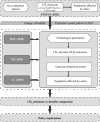CH4 mitigation potentials from China landfills and related environmental co-benefits
- PMID: 29978044
- PMCID: PMC6031376
- DOI: 10.1126/sciadv.aar8400
CH4 mitigation potentials from China landfills and related environmental co-benefits
Abstract
China's CH4 emissions from 1955 existing (old) and 495 planned (new) landfills are estimated and projected by adopting a bottom-up method, targeting a 2012 baseline year and a 2030 projected target year. Nine key CH4 mitigation measures are proposed for the CH4 mitigation assessment from landfills. Approximately 0.66 million metric tons (Mt) of CH4 and 1.14 Mt of CH4 will be released, respectively, from new and existing landfills under a 2030 business-as-usual (BAU) scenario, which is 23.5% lower than a U.S. Environmental Protection Agency estimation. It is estimated that 0.60 and 0.97 Mt of CH4 can be reduced under new policies (NP) and low-carbon (LC) policy scenarios, respectively. The combined biocover and landfill gas collection and flaring system is the most promising mitigation measure, while mechanical biological treatment and mineral landfill also contribute substantially to CH4 reduction. The odor-affected population under NP and LC scenarios will decrease by 39.5 and 64.2%, respectively, when compared to the 2030 BAU scenario. The LC scenario is a recommended policy for meeting China's nationally determined contribution targets and reducing the not-in-my-backyard impact due to this policy's significant reduction of CH4 emissions.
Figures




Similar articles
-
Mitigation of global greenhouse gas emissions from waste: conclusions and strategies from the Intergovernmental Panel on Climate Change (IPCC) Fourth Assessment Report. Working Group III (Mitigation).Waste Manag Res. 2008 Feb;26(1):11-32. doi: 10.1177/0734242X07088433. Waste Manag Res. 2008. PMID: 18338699 Review.
-
Mitigation of methane emissions in a pilot-scale biocover system at the AV Miljø Landfill, Denmark: 2. Methane oxidation.Waste Manag. 2017 May;63:203-212. doi: 10.1016/j.wasman.2017.01.012. Epub 2017 Feb 1. Waste Manag. 2017. PMID: 28161333
-
Environmental assessment of landfill gas mitigation using biocover and gas collection with energy utilisation at aging landfills.Waste Manag. 2023 Jun 15;165:40-50. doi: 10.1016/j.wasman.2023.04.014. Epub 2023 Apr 18. Waste Manag. 2023. PMID: 37080016
-
Greenhouse gas emissions estimation from proposed El Fukhary Landfill in the Gaza Strip.J Air Waste Manag Assoc. 2016 Jun;66(6):597-608. doi: 10.1080/10962247.2016.1154115. J Air Waste Manag Assoc. 2016. PMID: 27249105
-
A correction in the CDM methodological tool for estimating methane emissions from solid waste disposal sites.J Environ Manage. 2015 Dec 1;164:151-60. doi: 10.1016/j.jenvman.2015.08.048. Epub 2015 Sep 11. J Environ Manage. 2015. PMID: 26363977 Review.
Cited by
-
Big disparities in CH4 emission patterns from landfills between the United States and China and their behind driving forces.Fundam Res. 2022 Aug 27;5(2):734-739. doi: 10.1016/j.fmre.2022.08.006. eCollection 2025 Mar. Fundam Res. 2022. PMID: 40242531 Free PMC article.
-
Bioenergy in China: Evaluation of domestic biomass resources and the associated greenhouse gas mitigation potentials.Renew Sustain Energy Rev. 2020 Jul;127:109842. doi: 10.1016/j.rser.2020.109842. Epub 2020 Apr 8. Renew Sustain Energy Rev. 2020. PMID: 34234613 Free PMC article.
-
Slowdown in China's methane emission growth.Natl Sci Rev. 2024 Jun 26;11(8):nwae223. doi: 10.1093/nsr/nwae223. eCollection 2024 Aug. Natl Sci Rev. 2024. PMID: 39262925 Free PMC article.
-
Regional trends and drivers of the global methane budget.Glob Chang Biol. 2022 Jan;28(1):182-200. doi: 10.1111/gcb.15901. Epub 2021 Oct 27. Glob Chang Biol. 2022. PMID: 34553464 Free PMC article.
References
-
- United States Environmental Protection Agency (USEPA), Global Anthropogenic Non-CO2 Greenhouse Gas Emissions: 1990–2030 (2012); www.epa.gov/sites/production/files/2016-05/documents/epa_global_nonco2_p....
-
- Chai X., Tonjes D. J., Mahajan D., Methane emissions as energy reservoir: Context, scope, causes and mitigation strategies. Prog. Energy Combust. Sci. 56, 33–70 (2016).
-
- United States Environmental Protection Agency (USEPA), Global Mitigation of Non-CO2 Greenhouse Gases 2010-2030 (United States Environmental Protection Agency Office of Atmospheric Programs (6207J), EPA-430-R-13-011, 2013); www.epa.gov/sites/production/files/2016-07/documents/mac_report_2014-exe...
-
- National Bureau of Statistics of China (NBSC), China Statistical Yearbook (China Statistics Press, 2015) (in Chinese).
-
- China Association of Urban Environmental Sanitation (CAUES), Urban Environmental Sanitation Industry Development Report (China City Press, 2014).
Publication types
MeSH terms
Substances
LinkOut - more resources
Full Text Sources
Other Literature Sources
Miscellaneous

